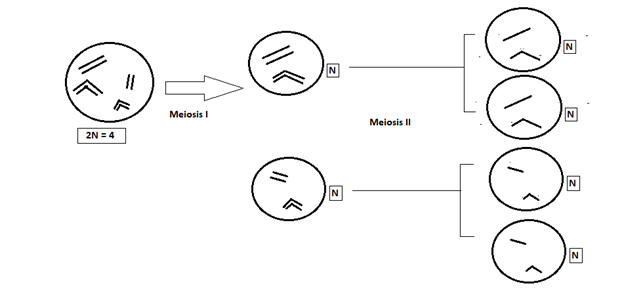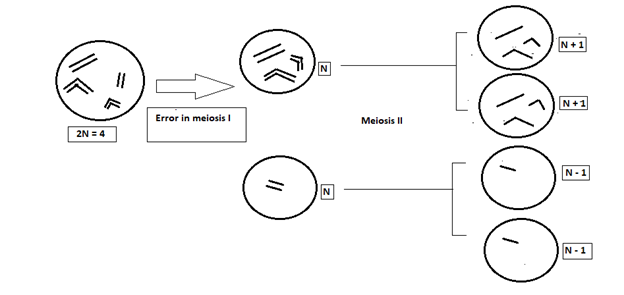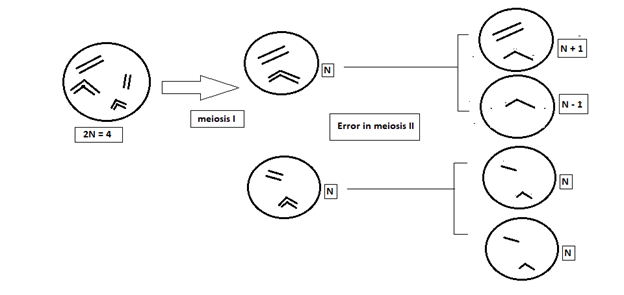Mechanism of Aneuploidy
Nondisjunction (the inability of homologous chromosomes at meiosis or sister chromatids at mitosis to separate equally to opposite poles) in mitosis or meiosis is the main cause of most aneuploids. Disjunction is the term used for the normal separation of chromatids to opposite poles during nuclear division or karyokinesis. Nondisjunction is simply the failure of this disjoining process. In order to understand the process, let’s take a simple example of a cell with 2N = 4 chromosomes. Aneuploidy could either occur due to error in meiosis I or error in meiosis II.

Error in Meiosis I
In the above picture, a cell having 4 chromosomes is dividing through meiosis. In meiosis I, it forms two daughter nuclei having 2 chromosomes each. We know that meiosis I is reductional division meaning the number of chromosomes would reduce to half. However, meiosis II is just like mitosis and also called as equational division. So, each nucleus formed in meiosis I will undergo meiosis II and overall, we get 4 cells with 2 chromosomes each. This is a normal condition when a cell divides through meiosis. However, when an error occurs at meiosis I then the condition changes as shown below:

When error in meiosis I occurs, it occurs due to nondisjunction of chromosomes. Instead of moving two sets of chromosomes to each nucleus, one nucleus receives three sets of chromosomes and the other receives only one set of chromosome. And meiosis II occurs normally. Instead of getting all 4 daughter cells with N number of chromosomes, two cells get N+1 number of chromosomes and the other two receives N-1 number of chromosomes.
Error in Meiosis II
Aneuploidy can occur due to error in meiosis II. It means, meiosis I occurs normally, but nondisjunction occurs during meiosis II that leads to aneuploidy. The whole process is shown in the picture below:

As shown above, meiosis I is normal, but in meiosis II, one daughter cell receives an extra chromosome while the other receives half of the required chromosomes. This leads to the formation of four daughter cells having N + 1, N – 1. N and N ploidy.
Types of Aneuploidy
- Monosomy – (2N – 1), this condition occurs by the fusion of two gametes with one gamete having (N-1) chromosome number and the other with a normal haploid N chromosome number.
(N-1) x (N) = 2N – 1; the zygote formed would have one chromosome less than the total number of chromosomes present in a normal or wild organism.
- Trisomy – (2N + 1), this condition occurs by the fusion of two gametes with one having (N + 1) chromosome number and the other with a normal haploid N chromosome number.
(N + 1) x (N) = 2N + 1; the zygote formed would have one chromosome extra than the total number of chromosomes present in a normal or wild organism.
- Nullisomy (2N – 2), this condition occurs by the fusion of two gametes with both gametes having (N-1) number of chromosomes.
(N-1) x (N-1) = (2N-2)
Well, there are many other aneuploidy conditions present such as tetrasomic (2N+2), double monosomic (2N-1-1), and double nullisomic (2N-2-2), etc.
Conclusion:
Aneuploidy is caused due to nondisjunction of chromosomes. Since, it is an abnormal condition, it leads to chromosomal disorders. Some of the chromosomal disorders in humans due to aneuploidy include Down’s syndrome, Patau syndrome, Edward syndrome, Klinefelter syndrome, and Turner syndrome, etc. However, these chromosomal disorders are non inheritable.
